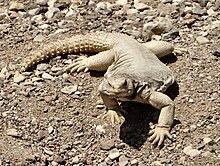Uromastyx aegyptia is a species of lizard in the family Agamidae. The species is endemic to North Africa and the Middle East.[1]
| Uromastyx aegyptia | |
|---|---|

| |
| Scientific classification | |
| Domain: | Eukaryota |
| Kingdom: | Animalia |
| Phylum: | Chordata |
| Class: | Reptilia |
| Order: | Squamata |
| Suborder: | Iguania |
| Family: | Agamidae |
| Genus: | Uromastyx |
| Species: | U. aegyptia
|
| Binomial name | |
| Uromastyx aegyptia (Forskål, 1775)
| |
| Synonyms | |
Common names
editCommon names for U. aegyptia include Egyptian mastigure,[3] Egyptian spiny-tailed lizard,[1] and, when referring to the subspecies Uromastyx aegyptia leptieni (see below), Leptien's mastigure.[3]
Description
editU. aegyptia is one of the largest members of the genus, with average lengths of 76 cm (30 in) for males.
Geographic range and conservation status
editU. aegyptia can be found in Egypt east of the Nile,[1][4] Israel, Syria, Jordan, the Arabian Peninsula, Iraq, and Iran. It has a patchy distribution and is rare in most parts of its range. It is believed to be in decline because of habitat loss and over-harvesting.[1]
Subspecies
editThree subspecies are recognized as being valid, including the nominotypical subspecies.[3]
- Uromastyx aegyptia aegyptia (Forskål, 1775)
- Uromastyx aegyptia leptieni Wilms & Böhme, 2000
- Uromastyx aegyptia microlepis Blanford, 1874
Etymology
editThe subspecific name, leptieni, is in honor of German herpetologist Rolf Leptien.[5]
Economic use
editU. aegyptia is locally known as dhab or ḍabb (Arabic: ضب). Its strong skin made good leather for the bedouins, while its meat was often considered as an alternative source of protein.[6]
Habitat
editU. aegyptia lives in open, flat, gravelly, stony, and rocky areas at elevations up to 1,500 m (4,900 ft) above sea level.[1]
References
edit- ^ a b c d e f Wilms, T. [in German]; Eid, E.K.A.; Al Johany, A.M.H; Amr, Z.S.S.; Els, J.; Baha El Din, S. [in German]; Disi, A.M.; Sharifi, M.; Papenfuss, T.; Shafiei Bafti, S.; Werner, Y.L. (2017) [errata version of 2012 assessment]. "Uromastyx aegyptia ". IUCN Red List of Threatened Species. 2012: e.T164729A115304711. doi:10.2305/IUCN.UK.2012.RLTS.T164729A1071308.en. Retrieved 20 February 2022.
- ^ "Appendices | CITES". cites.org. Retrieved 2022-01-14.
- ^ a b c d Uromastyx aegyptia at the Reptarium.cz Reptile Database. Accessed 23 February 2022.
- ^ Baha el Din, Sherif (2006). A Guide to Reptiles & Amphibians of Egypt. Cairo: The American University in Cairo Press. ISBN 978-9774249792.
- ^ Beolens, Bo; Watkins, Michael; Grayson, Michael (2011). The Eponym Dictionary of Reptiles. Baltimore: Johns Hopkins University Press. xiii + 296 pp. ISBN 978-1-4214-0135-5. (Uromastyx leptieni, p. 155).
- ^ Ghose, Tia (2014-03-05). "Leapin' Lizards! Medieval Arabs Ate the Scaly Creatures". LiveScience.com. Retrieved 2015-04-20.
Further reading
edit- Forskål P (1775). Descriptiones Animalium, Avium, Amphibiorum, Piscium, Insectorum, Vermium; quæ in Itinere Orientali Observit. Copenhagen: Möller. 164 pp. (Lacerta ægyptia, new species, p. 13). (in Latin).
External links
edit- Egyptian Spiny-Tail Agama, Sea Dwellers & Friends.
